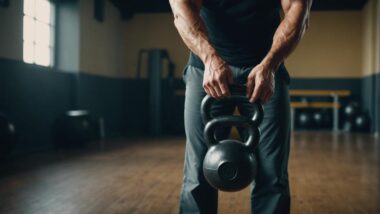You're about to unlock a powerful exercise that targets your chest, shoulders, and triceps, while engaging your core for stability, as you master the kettlebell standing chest press, a move that will elevate your overall upper body strength and endurance. By incorporating this exercise into your workout routine, you'll improve your posture, reduce the risk of injury, and enhance your overall athletic performance. To get started, stand with your feet shoulder-width apart, grip the kettlebell with both hands, and engage your chest muscles to press the weight upwards. Now, get ready to unleash your full potential and take your fitness to the next level.
Key Takeaways
- Stand with feet shoulder-width apart, toes pointing slightly outward, and knees slightly bent to maintain proper form.
- Engage core muscles and keep shoulders down and away from ears to generate power and stability.
- Focus on squeezing chest muscles at the top of the movement to ensure proper contraction and engagement.
- Use legs and hips to drive the movement, keeping elbows at a 45-degree angle to the body for optimal chest engagement.
- Avoid common mistakes like letting shoulders hunch forward and not engaging chest muscles effectively to get the most out of the exercise.
Kettlebell Standing Chest Press Benefits
What makes the kettlebell standing chest press an effective exercise is that it simultaneously strengthens your chest, shoulders, and triceps, while also engaging your core for stability.
This exercise is a game-changer for building strength and toning your upper body. As you press the kettlebell, you're targeting your pectoralis major, which is responsible for movements like pushing and throwing.
By incorporating the kettlebell standing chest press into your strength training routine, you'll notice improvements in your overall upper body strength and endurance.
In addition to building strength, this exercise also enhances your overall athletic performance. You'll be able to perform daily activities with more ease and confidence.
Plus, kettlebell exercises like the standing chest press can help improve your posture and reduce your risk of injury.
By incorporating this exercise into your kettlebell training, you'll be on your way to a stronger, more toned upper body.
Proper Form and Technique
As you prepare to perform the kettlebell standing chest press, it's essential to focus on proper form and technique to get the most out of the exercise and avoid injury.
You'll want to start by mastering the grip and stance fundamentals, ensuring your body positioning is on point, and working through a full range of motion.
Grip and Stance Fundamentals
When setting up for the kettlebell standing chest press, you'll want to establish a solid foundation by gripping the kettlebell with both hands and standing with your feet shoulder-width apart.
This stance will help you maintain balance and stability throughout the exercise. Keep your feet flat on the ground, with your toes pointing slightly outward, and your knees slightly bent.
This will allow you to generate power from your legs and core as you press the kettlebell upwards.
As you grip the kettlebell with both hands, keep your arms straight and engage your shoulders and chest muscles.
This will help you maintain proper form and technique, and avoid straining your back or shoulders. Keep your core tight, like you're in a plank position, to support the weight and maintain proper posture.
Body Positioning Essentials
To ensure a strong foundation for the kettlebell standing chest press, you'll need to nail down the essential body positioning elements, which will help you maintain proper form and generate maximum power.
Start by standing with your feet firmly shoulder-width apart, toes pointed slightly outward, and engage your core muscles to maintain a stable base.
Hold the kettlebell with both hands, keeping your elbows at a 45-degree angle and your forearms parallel to the ground, to ensure proper weight distribution and control.
Keep your shoulders down and away from your ears, squeezing your shoulder blades together to maintain proper posture and generate power.
Keep your chest up and your spine neutral, avoiding any arching or rounding of the back, to maintain proper form and prevent injury.
Engage your glutes and push your hips back slightly, keeping your weight evenly distributed between both legs, to generate power and maintain balance throughout the exercise.
Full Range of Motion
You'll achieve a full range of motion in the kettlebell standing chest press by executing a smooth, controlled movement that incorporates proper form and technique.
Stand with your feet shoulder-width apart and knees slightly bent, generating power and maintaining balance.
Hold the kettlebell with both hands, keeping your wrists straight and your arms straight with locked elbows.
Press the weight upwards, extending your arms fully to maximize the range of motion. As you lift, focus on squeezing your chest muscles at the top of the movement.
Lower the kettlebell back down to the starting position, keeping control throughout the entire range of motion and avoiding any jerky or bouncing movements.
Aim for a slow and controlled tempo, taking 2-3 seconds to press the weight upwards and 2-3 seconds to lower it back down.
Modifications for All Fitness Levels
Modify the kettlebell standing chest press to suit your fitness level by adjusting the weight, range of motion, and tempo to challenge your chest muscles and engage your core and stabilizer muscles.
As a beginner, start with a lighter weight and focus on proper form, squeezing your chest muscles at the top of the movement to ensure proper engagement. You'll build confidence and strength with each rep.
As you progress to intermediate fitness levels, increase the weight and add pauses at the bottom or top of the movement to increase time under tension for your chest muscles. This will challenge your muscles and improve overall fitness.
Advanced individuals can take it up a notch with single-arm or alternating arm kettlebell chest presses, which will engage your core and stabilizer muscles even more.
If you have mobility or flexibility limitations, try a partial range of motion or use a lighter weight to reduce the strain on your joints.
For a more intense workout, incorporate isometric holds or slow tempos to increase the time under tension for your chest muscles and challenge them further.
Common Mistakes to Avoid
One common mistake that can hinder the effectiveness of the kettlebell standing chest press is letting your shoulders hunch forward, which can put unnecessary strain on your joints and detract from the exercise's overall benefits.
When you hunch forward, you're not engaging your chest muscles as effectively, and you're putting your shoulders and back at risk of injury.
Another mistake to avoid isn't squeezing your shoulder blades together and keeping your core engaged.
This will help you maintain proper form and generate power for your Kettlebell Push.
When holding the kettlebell, make sure your palms are facing each other, with the kettlebells back against your chest.
Avoid using a Crush Grip, as this can cause strain on your forearms and wrists.
Instead, focus on pressing the kettlebells with your chest muscles.
Incorporating Into Your Workout Routine
When incorporating the kettlebell standing chest press into your workout routine, start with a manageable weight and focus on proper form to get the most out of this effective exercise.
Begin with 3 sets of 8-12 reps to target your chest muscles, anterior deltoids, and triceps brachii. As you progress, increase the weight or reps to continue challenging your muscles and promoting strength gains, but avoid sacrificing form for heavier weights.
Incorporating the kettlebell standing chest press into a full-body workout routine 2-3 times a week can help improve overall upper body strength, power, and endurance.
You'll be working multiple muscle groups simultaneously, making it an efficient addition to your workout routine. To vary the exercise and target different muscle groups, try alternating arms, using different grip positions, or incorporating pauses or pulses into the movement.
Tips for Maximum Chest Engagement
To get the most out of the kettlebell standing chest press, focus on proper form and engagement techniques to maximize your chest muscles' involvement in the exercise.
To do this, keep your core tight and engage your lats to maintain proper form and generate power. As you press the kettlebell, focus on squeezing your chest muscles at the top of the movement to ensure proper contraction and engagement.
Make sure to use a weight that allows for a full range of motion, avoiding heavy weights that may compromise form and reduce chest engagement. Keep your elbows at a 45-degree angle to your body, allowing your chest muscles to take over and reducing tricep involvement.
Take a deep breath and explosively press the kettlebell upwards, using your legs and hips to generate power and drive the movement.
Conclusion
You've mastered the kettlebell standing chest press!
Now, incorporate this exercise into your routine 2-3 times a week, aiming for 3 sets of 8-12 reps.
As you progress, increase the weight or reps to continue challenging your chest muscles.
Remember to focus on squeezing your chest at the top of the movement and avoid arching your back.
With consistent practice, you'll develop a stronger, more defined chest that will take your workouts to the next level!


